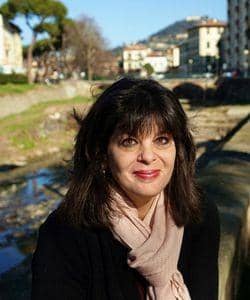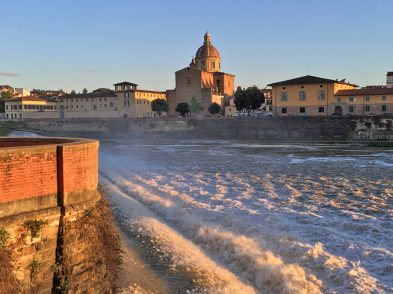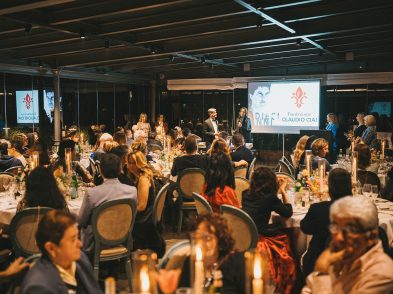When Elaine Ruffolo was an undergraduate studying baroque art in Rome for two weeks, she took a train to Florence for a visit. She had such a strong sense of belonging in Florence that she considered not returning to Wisconsin to complete her studies. It took Elaine a few years, but eventually, she returned to what she refers to as a ‘rich and varied life’ living in Florence.
Originally from Milwaukee, Elaine graduated from the University of Wisconsin with a degree in art history. Although she took studio art in high school and college, she felt she wasn’t talented enough to be an artist. It wasn’t until she took a basic art history class-from cave painting to Cubism-that she found her passion and immediately changed her major to art history.
With her bachelor’s degree, Elaine went to Amarillo, Texas, for an art restoration apprenticeship. She realized this type of work wasn’t for her: not only was it too solitary, but she became dizzy on the scaffolding. Still feeling a desire to return to Florence, Elaine searched for a way to do so. She found one that suited her perfectly: the Florence fellowship graduate program in Renaissance art at Syracuse University. She was accepted into the program, thus allowing her to study art history in New York for six months and to spend a year in Florence studying with art historian Rab Hatfield (see TF 29, 54, 69, 121). At the end of the program, she received her master’s degree in art history and became a teaching assistant for Syracuse University in Florence.

In 1990, while Elaine was in Florence, the Martelli law went into effect; through it, she was able to obtain working papers to live and work in Florence legally. Syracuse University hired Elaine to become a lecturer and to direct the field studies program; every semester, she organizes about 40 field trips throughout Italy for Syracuse undergraduates studying in Florence.
Besides her university job, Elaine searched for other ways to share her knowledge of Renaissance art in Florence. One way involved Trinity College’s Elder Hostel. The program hired her to take groups around Italy, lecturing from nothern Italy’s Lake District to Pompeii. Then, she was hired to develop cultural programs for many American museums, organizations and universities, like the Smithsonian, Young Presidents Organization, CEO International, National Trust for Historic Preservation and Friends of Florence.
After years of teaching undergraduates and taking tourists on private tours in and around Florence, Elaine came up with an idea for those residing here. She created a class, ‘Florence Masterpieces and Monuments,’ which runs for eight weeks each spring and fall. Every Thursday morning, she takes her resident students around Florence to teach them about the Renaissance, starting with Giotto and ending with Caravaggio. She schedules special tours and field trips, taking her class on secret itineraries and getting access to places that are closed to the public. She says that she still gets a thrill ‘bringing Florence alive by lecturing about the Renaissance while standing in front of where it happened.’
Last year, Elaine attended an 800-hour course to obtain the Guida turistica della Provincia di Firenze, the permit that all tour guides in Florence must have to take groups into museums as well as around town. She passed the written and oral exam and can now lecture on anything from the Etruscans to contemporary Florence.
Now Elaine is working on a book to share her knowledge with educated travelers, looking to enrich their experience during their next visit to Florence.
After living here for over 20 years, Elaine finds that Florence is not only where she belongs, but also where she thrives. Besides living in the city she chose as her home, she is also leading a life she loves, surrounded by the gifts of the Renaissance and sharing them with others.








